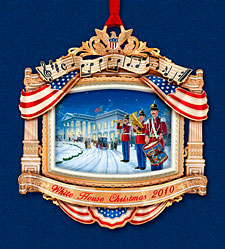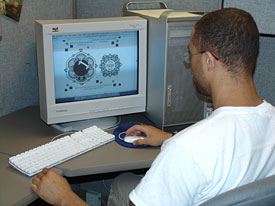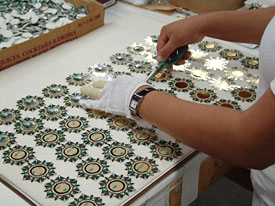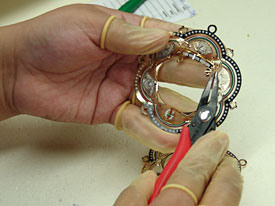ChemArt: Beautiful Memories Etched in Brass
 The finished 2010 Whitehouse Chrismas Ornament crafted by Chemart.
The finished 2010 Whitehouse Chrismas Ornament crafted by Chemart.Photograph courtesy of Kim Fyfe
Known for creating the famous annual White House Christmas ornament, ChemArt has been designing and producing etched brass keepsakes for people and companies all over the world since 1976.
Since 1981, ChemArt has created the etched brass keepsakes and holiday ornaments, for notable companies, universities, and even the White House.
As the holidays approach, thoughts turn to mouth-watering recipes and aromas, gift-giving, sparkling decorations and fond memories of past celebrations. ChemArt company is no exception as they prepared for the production of their brass Christmas ornaments for some of the most famous homes in America, including the White House.
The White House Historical Association, a non-profit chartered with the encouragement of Mrs. Jacqueline Kennedy, consulted with ChemArt since the inception of what has become the single largest ornament program in the United States.
The first ornament that ChemArt created was a miniature replica of a famous early American angel weather vane. It was promptly placed on the Christmas tree in the Blue Room by President Ronald Reagan in 1981. The second ornament, in 1982, was created in celebration of the 250th anniversary of George Washington's birth and depicted a weather vane commissioned by Washington himself. It began the chronological progression.
"The White House Historical Association knew they wanted this to be an annual ornament right from the start," Allison Hamilton, ChemArt's Marketing Manager. "Presidents have been represented in chronological order with themes focusing on the individual presidents, specific achievements, unique historical events during their terms, family life or significant modifications to the White House. Ornaments have limited distribution and the majority of sales are in the non-profit arena such as churches, schools, military family readiness and presidential libraries."
 A Chemart designer sketching out the ornament's layout.
A Chemart designer sketching out the ornament's layout. Photograph courtesy of Kim Fyfe
This year's 2010 ornament celebrates the role of music during the McKinley years when friends and family gathered on Sundays to sing hymns accompanied by a pianist in the White House's Blue Room.
"Over the years the collectors of these beautiful ornaments have significantly contributed to the educational mission of this Association and help fund preservation of the interior of the White House and its fine and decorative arts," says Michael Melton of the White House Historical Association.
In 2007, ChemArt obtained exclusive rights to sell these beautiful collectibles through their existing retail channels increasing visibility to a nationwide audience. All ornaments since the program's inception are available for collection.
With a degree in Chemistry from University of Rhode Island, Richard Beaupre originated an environmentally friendly aqueous dry film photo resist for use in imaging applications in 1976, then used his research technology to found ChemArt. Today, his veteran-owned company of plating and screen printing exceed many of the rigid industry standards.
Staffed with production artists, graphic designers and engineers working together on-site in Lincoln, Rhode Island, ChemArt is involved in every step of the process. For each ornament, ChemArt artists design, sketch and etch photographs and blueprints into precision parts. Their motto "With your vision and our expertise, we can create a lasting memory" has earned the patronage of many retailers, hospitals, historical and civic societies, fund raising foundations and charities, universities and many well-known organizations.
 Preparing the Whitehouse Christmas Ornament.
Preparing the Whitehouse Christmas Ornament.Photograph courtesy of Kim Fyfe
According to Hamilton, Beaupre did not necessarily intend to adapt the chemical etching process to brass ornaments, it just kind of evolved.
"He started with jewelry findings and later applied the technology to industrial parts," says Hamilton. "He soon applied this process to decorative ornaments and bookmarks, building his business customer by customer over the next 30 years."
ChemArt professionals are thoroughly versed in the intricacies of the design and manufacturing processes. They listen carefully and share ideas with the clients until they understand exactly what is wanted. When the Corvette Museum opened in 1994, it developed a first ornament with ChemArt for members, fans and visitors. Designs were created around themes like the 50th anniversary of the Corvette and other special commemorations. In 2000, MD Anderson Cancer Center's first annual collectible was based on the artwork of one of its pediatric patients.
Ornaments are made from thin sheets of solid brass that are cleaned of contaminants, polished, prepped, rinsed and coated with a resist. The metal is chemically altered when exposed to a UV light source. Film goes under the photosensitive light with the product image placed on top. This transfers the image from film to the metal. The film is stripped to expose the entire sheet.
After the masked image is formed, the metal is immersed into an etching solution that is acidic or caustic and tightly controlled. Etching is performed to specific depth or dimension. Score lines are made for easy bending. Raised letters, features or logos can be incorporated. The image is aligned by top and bottom photo tools which allow etching from both sides.
 Putting the final touches on the White House Christmas Ornament.
Putting the final touches on the White House Christmas Ornament.Photograph courtesy of Kim Fyfe
After the etching is complete, the photo resist is removed in a stripping solution. A bath of nickel is applied to give the ornament rigidity. Gold or silver provides a glistening finish.
When color is required to enhance the ornament, ChemArt's semi-automatic and hand operated screening equipment can register up to 19 colors per piece with precise detail. Epoxy paints are dried and cured in the oven to
guarantee adhesion of the color to the metal. Beautiful stained glass windows such as those housed in the Seiberling Mansion can be created.
Once the ornaments are removed from the sheets and the rough edges polished away, the individual parts are shaped and assembled by hand. When this is complete, the piece is strung with gold cord or ribbon and placed in a gift box.
Former Executive MBA student, Joseph Beck, was working for ChemArt when he designed a custom ornament presented as a gift to business dinner speakers at the University of Rhode Island, a principal public research school.
"This type of 3D keepsake provides a great gift that connects with donors, friends and graduates alike," Mark Higgins, Dean of the University. "It can serve as an ornament for a tree or reside on the donor's desktop."
Resources:
Also in this Issue:
- ChemArt: Beautiful Memories Etched in Brass
- Willi Singleton: Leading the Slow Clay Movement
- Courtney Fischer Jewelry: Expressions of Color and Texture
- Debby & Joel Arem: Three Ring Circuits
- Art Institute of Chicago Announces Major Acquisition of an Early 17th Century Copper Painting
